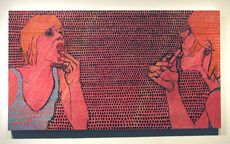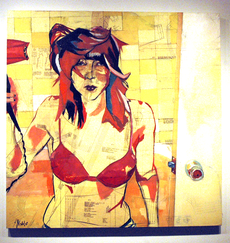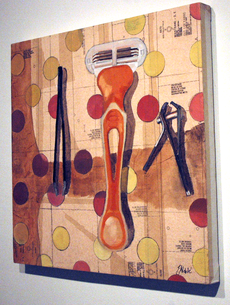Nicholls State University has a diverse environment, but upon entering the second story of Talbot Hall, the location of the Fine Arts Department, diversity takes on a whole new meaning. Inside the second floor of Talbot Hall are many art pieces created by faculty, current students and graduates. Although it could be considered a gallery within itself because of the amount of artwork displayed, the decorating does not stop there. If given the opportunity to peek inside many of the professors’ offices, one might be surprised. Not only are they decorated, but they are also a collaboration of many different cultures, time periods and life journeys.
Within this department, there is a sort of “open door policy,” Rob Carpenter, professor of painting, says. Faculty can be found eating lunch in one another’s offices, or students will simply stop by for a chat. The Fine Arts Department faculty members take pride in the relationships formed with their students. Although instructors individually teach different concentrations, they often rely on each other for inspiration and advice.
For many years, Carpenter’s office space was simply a converted balcony. This semester, however, he had the chance to move into a “real” office space. Although it is still a work in progress, he has big plans for it. His completed ideal office space will be, “comfortable, inviting and a good learning environment.”
He refers to his office as a “classroom outside the classroom,” and the amount of time he spends in this space varies each day. Students are encouraged to stop by and use his large collection of reference books.
Although each professor teaches different media, many are cross-trained and respect all types of artwork. In fact, many of the professors have one another’s artwork displayed in their offices.
“There is just something about interacting with people that inspires me,” Deborah Lillie, Ameen Art Gallery director and assistant professor of photography, says. Her office reflects her personality-a little multi-layered, homey and humorous.
While decorating her office environment, Lillie was quickly taken back to her college years. There was one particular professor that changed the way she thought about the office. His office seemed to bring out the “creative side” yet felt “comfy and calm,” Lillie says.
The pieces, which hang on her walls and ceiling, each have a story of their own. Pottery, photographs, quilting, shells, bones and even fish are displayed in her office. Many of the pieces on display showcase the “thought process of a mature artist.” The pieces of art that cover the walls create mosaic-like wallpaper that seems to inspire Lillie on a daily basis.
Lillie recalls a colleague of hers once saying, “If you’re going to be a graphic designer, at some point your house should look like a graphic designer.” The professors in this department definitely follow this rule.
While some offices are the most disorganized, organized spaces imaginable, others are calm and simple. David Horton, professor of graphic design, is a perfect example of simplicity. His office is “very tasteful” and the “gold standard,” Carpenter says.
Nothing is out of place in Horton’s office. Beautiful artwork, ranging from paintings to digital art, lines the walls, each perfectly leveled and spaced. His office space mimics his personality. Each time one encounters Horton, he is dressed professionally, and his clothes are perfectly pressed. He talks with a strong presence and is very direct. To some, this may sound uninviting, but there is something about his perfection that one could learn from.
Artists often choose to fill their homes or creative spaces with inspirational items. The offices in Nicholls’ Fine Arts Department are no different. The next time a break presents itself, stroll over and check out the second story of Talbot Hall. Maybe even consider poking a head inside a door or two and waving a greeting. It may be surprising how such little spaces can have such big style.

Artist Elizabeth Noble’s work, including this piece entitled “3 1/2 Inch Lift,” is currently displayed in Talbot Hall’s Ameen Art Gallery. (Bridgit Mire)

Artist Elizabeth Noble’s work, including this piece entitled “3 1/2 Inch Lift,” is currently displayed in Talbot Hall’s Ameen Art Gallery. (Bridgit Mire)

Artist Elizabeth Noble’s work, including this piece entitled “3 1/2 Inch Lift,” is currently displayed in Talbot Hall’s Ameen Art Gallery. (Bridgit Mire)








